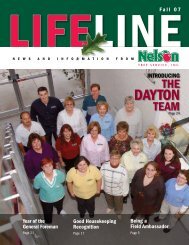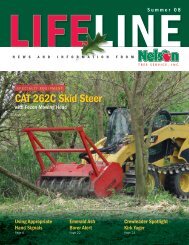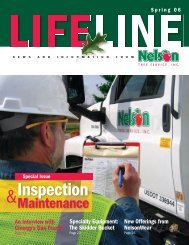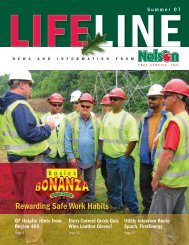LIFELINE
Winter 08 - Nelson Tree Service
Winter 08 - Nelson Tree Service
You also want an ePaper? Increase the reach of your titles
YUMPU automatically turns print PDFs into web optimized ePapers that Google loves.
F O C U S O N S A F E T Y<br />
SAFE HERBICIDE HANDLING<br />
continued from page 9<br />
1 0<br />
The storage area must be able to be securely locked<br />
when left unattended. Product should never be left<br />
in an unsecured area where others can gain access.<br />
Failure to secure and account for herbicide containers,<br />
whether full or empty, can result in serious legal<br />
problems.<br />
Temporary container labels are available from<br />
our Ashland facility to properly identify the<br />
product in temporary containers.<br />
Worker Exposure and First Aid<br />
The herbicide Specimen<br />
Label should always<br />
be considered the<br />
primary guide for proper<br />
handling of herbicide<br />
in regard to personal protective<br />
equipment (PPE) and<br />
exposure guidelines. However,<br />
some very basic principles should<br />
always be followed whenever workers<br />
are handling herbicides.<br />
While Nelson Tree applicators usually<br />
handle herbicides in a diluted form, there<br />
will still, always be, some minimum PPE<br />
requirements. For most herbicide, these requirements<br />
include all of Nelson’s standard PPE (hard<br />
hat, work boots, long pants and safety glasses), plus<br />
a long sleeved shirt. Depending on the type of herbicide,<br />
gloves may be required.<br />
The Specimen Label and MSDS provide the proper<br />
first aid requirements in the event of exposure. There<br />
are four types of acute exposure situations: dermal<br />
(through the skin), oral (swallowing), inhalation and<br />
through the eyes.<br />
Environmental Concerns<br />
Successful treatment of unwanted trees or brush has<br />
the potential to introduce negative consequences. If<br />
herbicides are used inappropriately, results such as off<br />
target spray damage to surrounding vegetation and<br />
trees, or contamination of groundwater could occur.<br />
Drift onto nearby plants can be a problem when<br />
using handheld equipment. Small quantities of spray,<br />
which may not be readily visible, can injure off target<br />
plants. Herbicides should not be sprayed when the<br />
wind is blowing toward crops or when ornamental<br />
plants are nearby. When treating trees and brush, a<br />
low pressure, coarse spray should be used and all sides<br />
of the target plant should be sprayed. Drift often occurs<br />
when trying to spray an entire<br />
plant from one side only.<br />
Other concerns involve<br />
run off, leaching and<br />
volatization. Most<br />
common is run<br />
off damage<br />
caused by<br />
The Specimen<br />
Label and MSDS<br />
provide the proper first<br />
aid requirements in the<br />
event of exposure.<br />
a hard rain just after application.<br />
Most herbicide products utilized by our<br />
company have been formulated to prevent<br />
these situations. But again, using proper application<br />
techniques is the key in preventing negative outcomes.<br />
Herbicides are an effective and relatively safe tool<br />
when used appropriately. The potential safety risks to<br />
applicators are extremely minimal. However, it is the<br />
applicator’s responsibility to make sure they are<br />
completely aware of all handling requirements that<br />
will keep them, their co-workers, and the general<br />
public safe.








